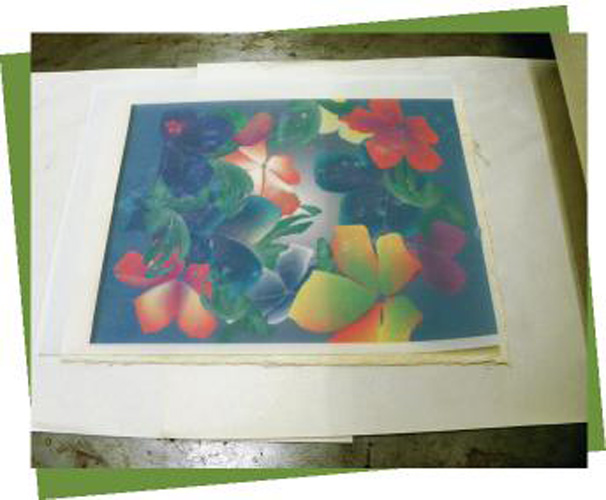Grafix Lesson Plan: Lesson 3
Project Description: Student artists need exposure to a variety of innovative materials that can be utilized in the creation of artwork. Materials possessing flexibility for problem solving challenge students to experiment and create imagery that is original and unique. Dura-Lar Matte Film and Clear Ink Jet Film are versatile surfaces that offer students the ability to expand their artistic skills and creative endeavors.
Designed by: Robert Hackbarth
Difficulty: Challenging
Materials:
- Grafix Dura-Lar Matte Film
- Markers, colored pencils
- Scanner, computer, digital editing software, ink jet printer
- Raw–unprimed canvas, canvas board panels, basswood or birch plywood
- Soaking tray
- Etching press with felt blankets
- Blotters
- Canvas stretchers or plywood surface
- Staple gun and staples to attach raw canvas to stretchers or plywood
- Pastels, oil pastels, acrylic paints or oil paints to work directly on transferred image
- Fixative for pastel
Note: Because of the variety of ink jet printers printing results may vary. Experimen¬tation is suggested. It is recommended that color saturation and brightness/contrast of photographs be increased within a photo-editing program. Subtle, low-key colors tend to print muddy and vary greatly depending on the surface texture and tone. However, inconsistencies and unexpected results lend to the artistic process.
Steps to Make This:
- Students will sketch or create an original image on Dura-Lar Matte Film using pencils, colored pencils, markers, inks, pastels, crayons, oil pastels or by using a digital paint/drawing program.
- Images will then be scanned into a computer, digitally altered if necessary and printed on a second sheet of Dura-Lar Matte Film using an ink jet printer.
This allows the artist flexibility to adjust various elements of the design, such as brightness and color saturation.
Method 1 – Printed image on Dura-Lar Matte to wet canvas
Prior to printing the image, soak a piece of unprimed raw canvas in a tray of water for five minutes. Adjust the pressure on the press to obtain a uniform transfer. Using blotters or newsprint, place the wet canvas between the sheets of paper and blot off the remaining water. The canvas will remain damp. Place the canvas face up on the etching press bed. Position the image that was printed on Dura-Lar Matte Film face down on the damp canvas. (Multiple images can be used for a montage effect.) Cover the Dura-Lar Matte Film and the damp canvas with newsprint and felt blankets and print the image. The majority of the ink jet print will transfer to the damp canvas, leaving a ghost of the original on the Dura-Lar Matte Film. To re-use the Dura-Lar Matte Film, clean with a damp sponge. (If an etching press is not available, use a pin press or rolling pin to add pressure to the back of the damp raw linen canvas. The resulting image will not be as dark as the etching press method, due to the amount of pressure that an etching press can generate.)
Option A: Students may like the transferred image as is or they may choose to add details and intensify colors by directly working onto the raw canvas using acrylics, oils, oil pastels, markers, crayons, colored pencils or pastel. If sketches were transferred, this process allows the student creativity to complete the image as desired.
Option B: Multiple raw canvas transferred images can be cut out and assembled as a montage or collaged onto a larger painting surface. Workable fixatif or clear polymer medium can be used to protect the image on the surface of the raw canvas.
Option C: Raw canvas transferred images can be cut out and sewn together to form stuffed, three-dimensional sculptures or puppets. Additional decorative elements can be painted or sewn onto the forms. Workable fixatif can be used to protect the surface of the raw canvas.
Method 2 – Printed image on Dura-Lar Matte Film to dry primed canvas board Transfer the ink jet printed image or multiple images directly onto a dry, primed canvas board using an etching press adjusted for the correct pressure. Place the canvas board face up on the press bed. Place the ink jet printed image(s) face down on the canvas board. Cover all with felt blankets and pull the image through the press. Less detailed transferred images will be revealed on the woven textural surface of the canvas board, eliminating the need for sketching, drawing or under painting the composition. A strong image will remain on the Dura-Lar Matte Film and this will provide an additional working surface. (See Option B)
Option A: Using the transferred image as “under painting,” students can draw and paint directly onto the surface of the canvas board using oil paints, acrylics, watercolors, markers, pastels, water-based oil pastels, crayons, inks and detail pens. The flexibility to use mixed media allows the student artist a range of experimentation possibilities that challenges their abilities to create original artwork.
Option B: The Dura-Lar Matte Film that was used to print the canvas board offers an artist the opportunity to work back into the ink jet print. Artists can add more color, texture and design elements to the inked side of the Dura-Lar Matte Film. Turning the film over creates a very soft image. Additional drawing/painting can be done on this side as well.
Method 3 – Printed image on Dura-Lar Matte Film to basswood or other light woods Transfer the ink jet printed image or multiple images directly onto basswood or other lighter woods using an etching press adjusted for the correct pressure. Place the basswood face up on the press bed. Place the ink jet printed image(s) face down on the wood. Cover with felt blankets and pull the image through the press. This process works well with photographs to achieve a subtle appearance that also allows artist/ photographers to use encaustic wax processes directly on the wooden surface. See example of finished artwork on first page.







